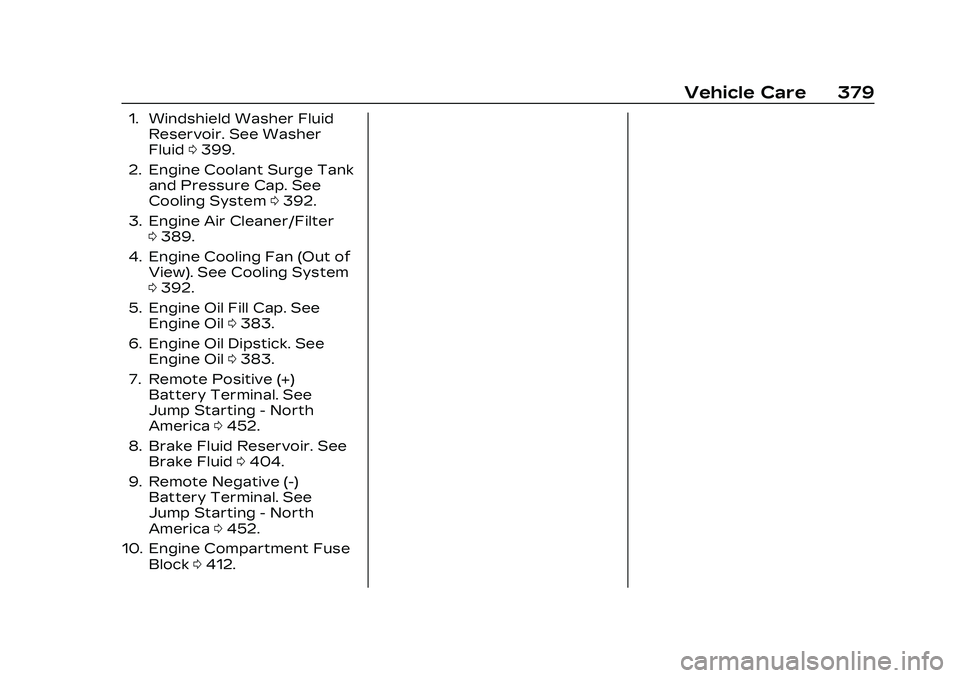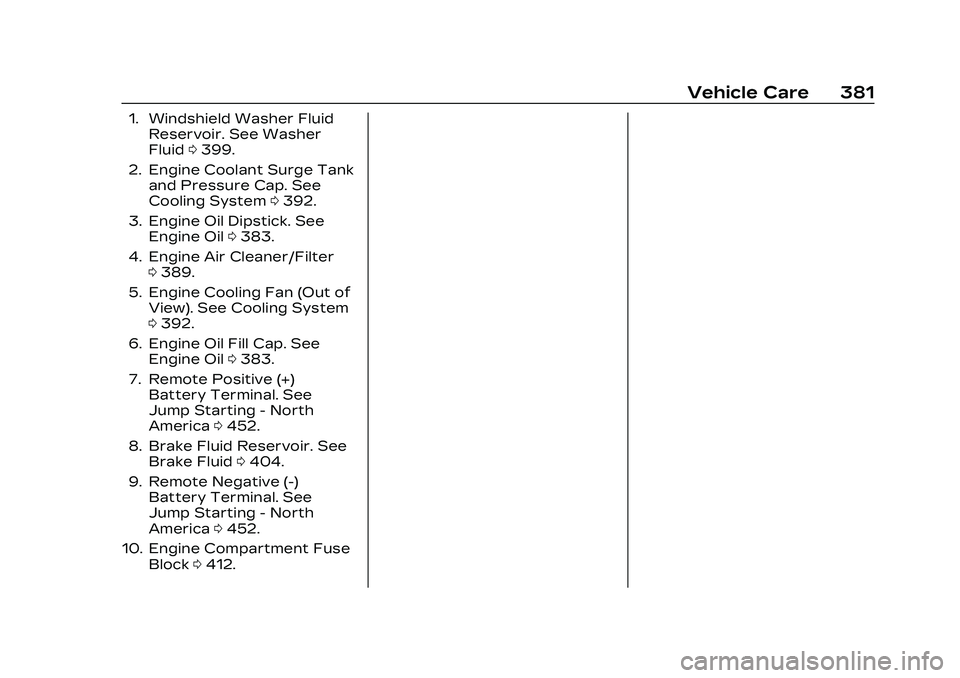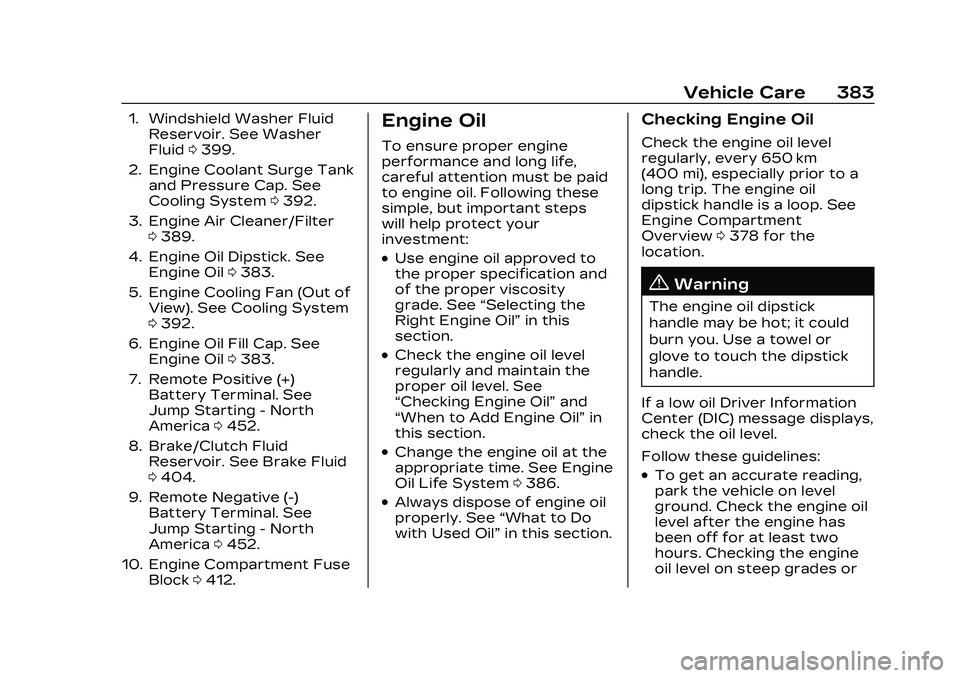engine coolant CADILLAC CT5 2023 User Guide
[x] Cancel search | Manufacturer: CADILLAC, Model Year: 2023, Model line: CT5, Model: CADILLAC CT5 2023Pages: 526, PDF Size: 6.85 MB
Page 288 of 526

Cadillac CT5 Owner Manual (GMNA-Localizing-U.S./Canada-16500419) -
2023 - CRC - 5/10/22
Driving and Operating 287
.Be disabled when the
coolant temperature is
below 0 °C (32 °F).
Drive Systems
All-Wheel Drive
Vehicles with this feature
always send engine power to
all four wheels. It is fully
automatic, and adjusts itself as
needed for road conditions.
Brakes
Electric Brake Boost
Vehicles equipped with
electric brake boost have
hydraulic brake circuits that
are electronically controlled
when the brake pedal is
applied during normal
operation. The system
performs routine tests and
turns off within a few minutes
after the vehicle is turned off.
Noise may be heard during
this time. If the brake pedal is
pressed during the tests orwhen the electric brake boost
system is off, a noticeable
change in pedal force and
travel may be felt. This is
normal.
Antilock Brake
System (ABS)
The Antilock Brake System
(ABS) helps prevent a braking
skid and maintain steering
while braking hard.
If there is a problem with ABS,
this warning light stays on.
See Antilock Brake System
(ABS) Warning Light
0128.
ABS does not change the time
needed to get a foot on the
brake pedal and does not
always decrease stopping
distance. If you get too close
to the vehicle ahead, there will not be enough time to apply
the brakes if that vehicle
suddenly slows or stops.
Always leave enough room
ahead to stop, even with ABS.
Using ABS
Do not pump the brakes. Just
hold the brake pedal down
firmly. Hearing and feeling ABS
operate is normal.
Braking in Emergencies
ABS allows steering and
braking at the same time. In
many emergencies, steering
can help even more than
braking.
Page 368 of 526

Cadillac CT5 Owner Manual (GMNA-Localizing-U.S./Canada-16500419) -
2023 - CRC - 5/10/22
Driving and Operating 367
Towing with a Stability
Control System
When towing, the stability
control system might be
heard. The system reacts to
vehicle movement caused by
the trailer, which mainly occurs
during cornering. This is
normal when towing heavier
trailers.
Following Distance
Stay at least twice as far
behind the vehicle ahead as
you would when driving
without a trailer. This can help
to avoid heavy braking and
sudden turns.
Passing
More passing distance is
needed when towing a trailer.
The combination of the vehicle
and trailer will not accelerate
as quickly and is much longer
than the vehicle alone. It is
necessary to go much farther
beyond the passed vehiclebefore returning to the lane.
Pass on level roadways. Avoid
passing on hills if possible.
Backing Up
Hold the bottom of the
steering wheel with one hand.
To move the trailer to the left,
move that hand to the left. To
move the trailer to the right,
move that hand to the right.
Always back up slowly and,
if possible, have someone
guide you.
Making Turns
Caution
Turn more slowly and make
wider arcs when towing a
trailer to prevent damage to
your vehicle. Making very
sharp turns could cause the
trailer to contact the vehicle.
Make wider turns than normal
when towing, so trailer will not
go over soft shoulders, over
curbs, or strike road signs,
trees, or other objects. Always signal turns well in advance.
Do not steer or brake
suddenly.
Driving on Grades
Reduce speed and shift to a
lower gear before starting
down a long or steep downhill
grade. If the transmission is
not shifted down, the brakes
may overheat and result in
reduced braking efficiency.
Vehicles can tow in D (Drive).
Shift the transmission to a
lower gear if the transmission
shifts too often under heavy
loads and/or hilly conditions.
When towing at higher
altitudes, engine coolant will
boil at a lower temperature
than at lower altitudes. If the
engine is turned off
immediately after towing at
high altitude on steep uphill
grades, the vehicle could show
signs similar to engine
overheating. To avoid this, let
the engine run, preferably on
level ground, with the
Page 380 of 526

Cadillac CT5 Owner Manual (GMNA-Localizing-U.S./Canada-16500419) -
2023 - CRC - 5/6/22
Vehicle Care 379
1. Windshield Washer FluidReservoir. See Washer
Fluid 0399.
2. Engine Coolant Surge Tank and Pressure Cap. See
Cooling System 0392.
3. Engine Air Cleaner/Filter 0389.
4. Engine Cooling Fan (Out of View). See Cooling System
0392.
5. Engine Oil Fill Cap. See Engine Oil 0383.
6. Engine Oil Dipstick. See Engine Oil 0383.
7. Remote Positive (+) Battery Terminal. See
Jump Starting - North
America 0452.
8. Brake Fluid Reservoir. See Brake Fluid 0404.
9. Remote Negative (-) Battery Terminal. See
Jump Starting - North
America 0452.
10. Engine Compartment Fuse Block 0412.
Page 382 of 526

Cadillac CT5 Owner Manual (GMNA-Localizing-U.S./Canada-16500419) -
2023 - CRC - 5/6/22
Vehicle Care 381
1. Windshield Washer FluidReservoir. See Washer
Fluid 0399.
2. Engine Coolant Surge Tank and Pressure Cap. See
Cooling System 0392.
3. Engine Oil Dipstick. See Engine Oil 0383.
4. Engine Air Cleaner/Filter 0389.
5. Engine Cooling Fan (Out of View). See Cooling System
0392.
6. Engine Oil Fill Cap. See Engine Oil 0383.
7. Remote Positive (+) Battery Terminal. See
Jump Starting - North
America 0452.
8. Brake Fluid Reservoir. See Brake Fluid 0404.
9. Remote Negative (-) Battery Terminal. See
Jump Starting - North
America 0452.
10. Engine Compartment Fuse Block 0412.
Page 384 of 526

Cadillac CT5 Owner Manual (GMNA-Localizing-U.S./Canada-16500419) -
2023 - CRC - 5/6/22
Vehicle Care 383
1. Windshield Washer FluidReservoir. See Washer
Fluid 0399.
2. Engine Coolant Surge Tank and Pressure Cap. See
Cooling System 0392.
3. Engine Air Cleaner/Filter 0389.
4. Engine Oil Dipstick. See Engine Oil 0383.
5. Engine Cooling Fan (Out of View). See Cooling System
0392.
6. Engine Oil Fill Cap. See Engine Oil 0383.
7. Remote Positive (+) Battery Terminal. See
Jump Starting - North
America 0452.
8. Brake/Clutch Fluid Reservoir. See Brake Fluid
0404.
9. Remote Negative (-) Battery Terminal. See
Jump Starting - North
America 0452.
10. Engine Compartment Fuse Block 0412.Engine Oil
To ensure proper engine
performance and long life,
careful attention must be paid
to engine oil. Following these
simple, but important steps
will help protect your
investment:
.Use engine oil approved to
the proper specification and
of the proper viscosity
grade. See “Selecting the
Right Engine Oil” in this
section.
.Check the engine oil level
regularly and maintain the
proper oil level. See
“Checking Engine Oil” and
“When to Add Engine Oil” in
this section.
.Change the engine oil at the
appropriate time. See Engine
Oil Life System 0386.
.Always dispose of engine oil
properly. See “What to Do
with Used Oil” in this section.
Checking Engine Oil
Check the engine oil level
regularly, every 650 km
(400 mi), especially prior to a
long trip. The engine oil
dipstick handle is a loop. See
Engine Compartment
Overview0378 for the
location.
{Warning
The engine oil dipstick
handle may be hot; it could
burn you. Use a towel or
glove to touch the dipstick
handle.
If a low oil Driver Information
Center (DIC) message displays,
check the oil level.
Follow these guidelines:
.To get an accurate reading,
park the vehicle on level
ground. Check the engine oil
level after the engine has
been off for at least two
hours. Checking the engine
oil level on steep grades or
Page 393 of 526

Cadillac CT5 Owner Manual (GMNA-Localizing-U.S./Canada-16500419) -
2023 - CRC - 5/6/22
392 Vehicle Care
8. Reverse Steps 1–4 toreinstall the engine air
cleaner/filter cover.
9. If equipped, reset the engine air filter life system
after replacing the engine
air filter. See Engine Air
Filter Life System 0389.
6.2L V8 Engine
1. Remove the six screws on top of the air cleaner/filter
cover.
2. Lift the air/cleaner/filter cover away from the air
cleaner/filter housing.
{Warning
If part replacement is
necessary, the part must be
replaced with one of the
same part number or with an
equivalent part. Use of a
replacement part without
the same fit, form, and
function may result in
personal injury or damage to
the vehicle.
4. Pull out the air cleaner/ filter.
5. Inspect or replace the air cleaner/filter.
6. Reverse Steps 1–3 to reinstall the air cleaner/
filter cover.
7. If equipped, reset the engine air filter life system
after replacing the engine
air filter. See Engine Air
Filter Life System 0389.
Cooling System
The cooling system allows the
engine to maintain the correct
working temperature.
2.0L L4 Engine
1. Engine Coolant Surge
Tank and Pressure Cap
2. Engine Cooling Fan (Out of View)
Page 394 of 526

Cadillac CT5 Owner Manual (GMNA-Localizing-U.S./Canada-16500419) -
2023 - CRC - 5/6/22
Vehicle Care 393
3.0L V6 Engine
1. Engine Coolant SurgeTank and Pressure Cap
2. Engine Cooling Fan (Out of View)
6.2L V8 Engine
1. Engine Coolant Surge
Tank and Pressure Cap
2. Engine Cooling Fan (Out of View)
{Warning
An underhood electric fan
can start up even when the
engine is not running and
can cause injury. Keep
hands, clothing, and tools
away from any underhood
electric fan.
{Warning
Do not touch heater or
radiator hoses, or other
engine parts. They can be
very hot and can burn you.
Do not run the engine if
there is a leak; all coolant
could leak out. That could
cause an engine fire and can
burn you. Fix any leak before
driving the vehicle.
Caution
Do not use anything other
than a mix of DEX-COOL
coolant that meets GM
Standard GMW3420 and
clean, drinkable water.
Anything else can cause
damage to the engine
cooling system and the
vehicle, which would not be
covered by the vehicle
warranty.
Page 395 of 526

Cadillac CT5 Owner Manual (GMNA-Localizing-U.S./Canada-16500419) -
2023 - CRC - 5/6/22
394 Vehicle Care
Engine Coolant
The cooling system in the
vehicle is filled with
DEX-COOL engine coolant.
See Maintenance Schedule
0471 and
Recommended Fluids and
Lubricants 0476.
The following explains the
cooling system and how to
check and add coolant when it
is low. If there is a problem
with engine overheating, see
Engine Overheating 0398.
What to Use
{Warning
Do not touch heater or
radiator hoses, or other
engine parts. They can be
very hot and can burn you.
Do not run the engine if
there is a leak; all coolant
could leak out. That could
cause an engine fire and can
burn you. Fix any leak before
driving the vehicle. Use a 50/50 mixture of clean
drinkable water and
DEX-COOL coolant. This
mixture:
.Gives freezing protection
down to
−37 °C (−34 °F),
outside temperature.
.Gives boiling protection up
to 129 °C (265 °F), engine
temperature.
.Protects against rust and
corrosion.
.Will not damage aluminum
parts.
.Helps keep the proper
engine temperature.
Caution
Do not use anything other
than a mix of DEX-COOL
coolant that meets GM
Standard GMW3420 and
clean, drinkable water.
Anything else can cause
damage to the engine
cooling system and the
(Continued)
Caution (Continued)
vehicle, which would not be
covered by the vehicle
warranty.
Never dispose of engine
coolant by putting it in the
trash, pouring it on the
ground, or into sewers,
streams, or bodies of water.
Have the coolant changed by
an authorized service center,
familiar with legal
requirements regarding used
coolant disposal. This will help
protect the environment and
your health.
Checking Coolant
The vehicle must be on a level
surface when checking the
coolant level.
It is normal to see coolant
moving in the upper coolant
hose return line when the
engine is running. It is also
normal to see bubbles
entering the surge tank
through the small hose.
Page 396 of 526

Cadillac CT5 Owner Manual (GMNA-Localizing-U.S./Canada-16500419) -
2023 - CRC - 5/6/22
Vehicle Care 395
Check to see if coolant is
visible in the coolant surge
tank. If the coolant inside the
coolant surge tank is boiling,
do not do anything else until it
cools down.
If coolant is visible but the
coolant level is not at or above
the indicated mark, add a
50/50 mixture of clean
drinkable water and
DEX-COOL coolant.
Be sure the cooling system is
cool before this is done.If no coolant is visible in the
coolant surge tank, add
coolant as follows:
How to Add Coolant to the
Coolant Surge Tank
{Warning
Spilling coolant on hot
engine parts can burn you.
Coolant contains ethylene
glycol and it will burn if the
engine parts are hot enough.
{Warning
Plain water, or other liquids
such as alcohol, can boil
before the proper coolant
mixture will. With plain water
or the wrong mixture, the
engine could get too hot but
there would not be an
overheat warning. The
engine could catch fire and
you or others could be
burned.
{Warning
Steam and scalding liquids
from a hot cooling system
are under pressure. Turning
the pressure cap, even a
little, can cause them to
come out at high speed and
you could be burned. Never
turn the cap when the
cooling system, including the
pressure cap, is hot. Wait for
the cooling system and
pressure cap to cool.
Caution
Failure to follow the specific
coolant fill procedure could
cause the engine to
overheat and could cause
system damage. If coolant is
not visible in the surge tank,
contact your dealer.
Page 397 of 526

Cadillac CT5 Owner Manual (GMNA-Localizing-U.S./Canada-16500419) -
2023 - CRC - 5/6/22
396 Vehicle Care
If no problem is found, check
to see if coolant is visible in
the coolant surge tank.
If coolant is visible but the
coolant level is not at or above
the indicated mark, add a
50/50 mixture of clean,
drinkable water and
DEX-COOL coolant at the
coolant surge tank, but be
sure the cooling system,
including the coolant surge
tank pressure cap, is cool
before you do it.
2.0L L4 Engine
Automatic Coolant Service
Fill Instructions
The vehicle is equipped with a
service feature that assists
with filling and removing air
from the cooling system after
service of components or
when coolant is added after
being too low.To use the service feature:
1. With a cold system, add
coolant to the indicated
line on the surge tank.
2. Replace the pressure cap on the surge tank.
To activate the service
feature: 1. Connect the vehicle to a battery charger.
2. Turn the ignition on. See Ignition Positions 0267.
3. Turn off the air conditioning.
4. Set the parking brake. 5. At the same time, press
the accelerator and the
brake pedal for
two seconds, then release.
6. At the end of the cycle, check the coolant level in
the surge tank and add
coolant if it is below the
indicated line. Turn the
ignition off, allow the
Electronic Control Module
(ECM) to go to sleep, about
two minutes, and repeat
Steps 2–6.
Listen for pump activation and
movement of the control
valves while watching the level
of the coolant in the surge
tank. If the tank empties, turn
the ignition off, carefully
remove the pressure cap, refill
to the indicated line, replace
the pressure cap, and repeat
Steps 2–6.
The fill and air removal
process will run for
approximately 15 minutes.